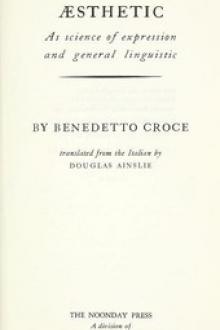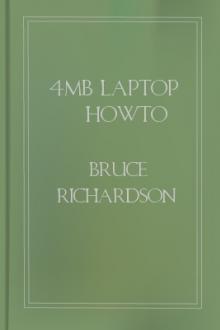Aesthetic as Science of Expression and General Linguistic, Benedetto Croce [read e books online free TXT] 📗

- Author: Benedetto Croce
- Performer: 1426434839
Book online «Aesthetic as Science of Expression and General Linguistic, Benedetto Croce [read e books online free TXT] 📗». Author Benedetto Croce
On other occasions externalization is limited by the impossibility of producing certain effects artificially. Thus we may mix the colouring matters, but we cannot create a powerful voice or a personage and an appearance appropriate to this or that personage of a drama. We must therefore seek for them among things already existing, and make use of them when we find them. When, therefore, we adopt a great number of combinations already existing in nature, such as we should not be able to produce artificially if they did not exist, the result is called mixed beauty.
[Sidenote] Writings.
We must distinguish from artificial beauty those instruments of reproduction called writings, such as alphabets, musical notes, hieroglyphics, and all pseudo-languages, from the language of flowers and flags, to the language of patches (so much the vogue in the society of the eighteenth century). Writings are not physical facts which arouse directly impressions answering to aesthetic expressions; they are simple indications of what must be done in order to produce such physical facts. A series of graphic signs serves to remind us of the movements which we must execute with our vocal apparatus in order to emit certain definite sounds. If, through practice, we become able to hear the words without opening our mouths and (what is much more difficult) to hear the sounds by running the eye down the page of the music, all this does not alter anything of the nature of the writings, which are altogether different from direct physical beauty. No one calls the book which contains the Divine Comedy, or the portfolio which contains Don Giovanni, beautiful in the same sense as the block of marble which contains Michael Angelo’s Moses, or the piece of coloured wood which contains the Transfiguration are metaphorically called beautiful. Both serve for the reproduction of the beautiful, but the former by a far longer and far more indirect route than the latter.
[Sidenote] The beautiful as free and not free.
Another division of the beautiful, which is still found in treatises, is that into free and not free. By beauties that are not free, are understood those objects which have to serve a double purpose, extra-aesthetic and aesthetic (stimulants of intuitions); and since it appears that the first purpose limits and impedes the second, the beautiful object resulting therefrom has been considered as a beauty that is not free.
Architectural works are especially cited; and precisely for this reason, has architecture often been excluded from the number of the so-called fine arts. A temple must be above all things adapted to the use of a cult; a house must contain all the rooms requisite for commodity of living, and they must be arranged with a view to this commodity; a fortress must be a construction capable of resisting the attacks of certain armies and the blows of certain instruments of war. It is therefore held that the architect’s field is limited: he may be able to embellish to some extent the temple, the house, the fortress; but his hands are bound by the object of these buildings, and he can only manifest that part of his vision of beauty in their construction which does not impair their extrinsic, but fundamental, objects.
Other examples are taken from what is called art applied to industry.
Plates, glasses, knives, guns, and combs can be made beautiful; but it is held that their beauty must not so far exceed as to prevent our eating from the plate, drinking from the glass, cutting with the knife, firing off the gun, or combing one’s hair with the comb. The same is said of the art of printing: a book should be beautiful, but not to the extent of its being difficult or impossible to read it.
[Sidenote] Critique of the beautiful that is not free.
In respect to all this, we must observe, in the first place, that the external purpose, precisely because it is such, does not of necessity limit or trammel the other purpose of being a stimulus to aesthetic reproduction. Nothing, therefore, can be more erroneous than the thesis that architecture, for example, is by its nature not free and imperfect, since it must also fulfil other practical objects. Beautiful architectural works, however, themselves undertake to deny this by their simple presence.
In the second place, not only are the two objects not necessarily in opposition; but, we must add, the artist always has the means of preventing this contradiction from taking place. In what way? By taking, as the material of his intuition and aesthetic externalization, precisely the destination of the object, which serves a practical end.
He will not need to add anything to the object, in order to make it the instrument of aesthetic intuitions: it will be so, if perfectly adapted to its practical purpose. Rustic dwellings and palaces, churches and barracks, swords and ploughs, are beautiful, not in so far as they are embellished and adorned, but in so far as they express the purpose for which they were made. A garment is only beautiful because it is quite suitable to a given person in given conditions. The sword bound to the side of the warrior Rinaldo by the amorous Armida was not beautiful: “so adorned that it seemed a useless ornament, not the warlike instrument of a warrior.” It was beautiful, if you will, in the eyes and imagination of the sorceress, who loved her lover in this effeminate way. The aesthetic fact can always accompany the practical fact, because expression is truth.
It cannot, however, be denied that aesthetic contemplation sometimes hinders practical use. For instance, it is a quite common experience to find certain new things so well adapted to their purpose, and yet so beautiful, that people occasionally feel scruples in maltreating them by using after contemplating them, which amounts to consuming them. It was for this reason that King Frederick William of Prussia evinced repugnance to ordering his magnificent grenadiers, so well suited for war, to endure the strain of battle; but his less aesthetic son, Frederick the Great, obtained from them excellent services.
[Sidenote] The stimulants of production.
It might be objected to the explanation of the physically beautiful as a simple adjunct for the reproduction of the internally beautiful, that is to say, of expressions, that the artist creates his expressions by painting or by sculpturing, by writing or by composing, and that therefore the physically beautiful, instead of following, sometimes precedes the aesthetically beautiful. This would be a somewhat superficial mode of understanding the procedure of the artist, who never makes a stroke with his brush without having previously seen it with his imagination; and if he has not yet seen it, he will make the stroke, not in order to externalize his expression (which does not yet exist), but as though to have a rallying point for ulterior meditation and for internal concentration. The physical point on which he leans is not the physically beautiful, instrument of reproduction, but what may be called a pedagogic means, similar to retiring into solitude, or to the many other expedients, frequently very strange, adopted by artists and philosophers, who vary in these according to their various idiosyncrasies. The old aesthetician Baumgarten advised poets to ride on horseback, as a means of inspiration, to drink wine in moderation, and (provided they were chaste) to look at beautiful women.
XIVMISTAKES ARISING FROM THE CONFUSION BETWEEN PHYSIC AND AESTHETIC
It is necessary to mention a series of scientific mistakes which have arisen from the failure to understand the purely external relation between the aesthetic fact or artistic vision, and the physical fact or instrument, which serves as an aid to reproduce it. We must here indicate the proper criticism, which derives from what has already been said.
[Sidenote] Critique of aesthetic associationism
That form of associationism which identifies the aesthetic fact with the association of two images finds a place among these errors. By what path has it been possible to arrive at such a mistake, against which our aesthetic consciousness, which is a consciousness of perfect unity, never of duality, rebels? Just because the physical and the aesthetic facts have been considered separately, as two distinct images, which enter the spirit, the one drawn forth from the other, the one first and the other afterwards. A picture is divided into the image of the picture and the image of the meaning of the picture; a poem, into the image of the words and the image of the meaning of the words. But this dualism of images is non-existent: the physical fact does not enter the spirit as an image, but causes the reproduction of the image (the only image, which is the aesthetic fact), in so far as it blindly stimulates the psychic organism and produces an impression answering to the aesthetic expression already produced.
The efforts of the associationists (the usurpers of to-day in the field of Aesthetic) to emerge from the difficulty, and to reaffirm in some way the unity which has been destroyed by their principle of associationism, are highly instructive. Some maintain that the image called back again is unconscious; others, leaving unconsciousness alone, hold that, on the contrary, it is vague, vaporous, confused, thus reducing the force of the aesthetic fact to the weakness of bad memory. But the dilemma is inexorable: either keep association and give up unity, or keep unity and give up association. No third way out of the difficulty exists.
[Sidenote] Critique of aesthetic physic.
From the failure to analyze so-called natural beauty thoroughly, and to recognize that it is simply an incident of aesthetic reproduction, and from having, on the contrary, looked upon it as given in nature, is derived all that portion of treatises upon Aesthetic which is entitled The Beautiful in Nature or Aesthetic Physic; sometimes even subdivided, save the mark! into Aesthetic Mineralogy, Botany, and Zoology. We do not wish to deny that such treatises contain many just remarks, and are sometimes themselves works of art, in so far as they represent beautifully the imaginings and fantasies, that is the impressions, of their authors. But we must state that it is scientifically false to ask oneself if the dog be beautiful, and the ornithorhynchus ugly; if the lily be beautiful, and the artichoke ugly.
Indeed, the error is here double. On one hand, aesthetic Physic falls back into the equivoke of the theory of artistic and literary classes, by attempting to determine aesthetically the abstractions of our intellect; on the other, fails to recognize, as we said, the true formation of so-called natural beauty; for which the question as to whether some given individual animal, flower, or man be beautiful or ugly, is altogether excluded. What is not produced by the aesthetic spirit, or cannot be referred to it, is neither beautiful nor ugly. The aesthetic process arises from the ideal relations in which natural objects are arranged.
[Sidenote] Critique of the theory of the beauty of the human body.
The double error can be exemplified by the question, upon which whole volumes have been written, as to the Beauty of the human body. Here it is necessary, above all things, to urge those who discuss this subject from the abstract toward the concrete, by asking: “What do you mean by the human body, that of the male, of the female,





Comments (0)